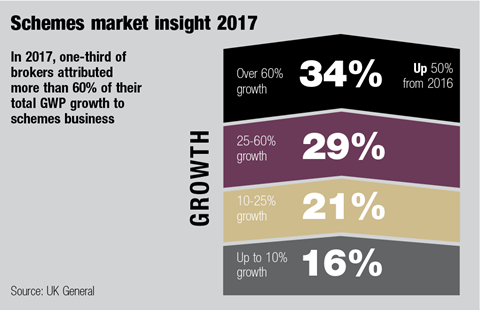Some of the more impressive scheme ideas in recent years have exploited new data sources and e-marketing capabilities
The evolution of the UK economy has expanded the potential opportunity for broker-led insurance schemes targeting SME customer segments in recent years. According to the Office for National Statistics (ONS), the number of UK business births increased by 9.3% between 2014 and 2015, the highest recorded since comparable records began in 2000. In broad industry terms, the highest number of new business start-ups were in business administration and support services.
The growth of new businesses in new sectors, including the sharing economy, creates innovation and opportunities. The start-up and SME space shows a number of burgeoning sectors including microbreweries, with a new brewery opening every other day according to the Pub Association, artisan bakers, co-working offices, mobile catering, analytics-based firms, Victoriana products and boutique care homes just some of the growing niches.
“Ideas nearly always come about by accident,” says SEIB CEO Barry Fehler. “The last idea we had was to develop a scheme for dog grooming vans. There are quite a few of them popping up and we recognised the demand for it. They’ve got washing equipment in their vans and we were able to come up with a suitable rate for them, because they’re not driven by 17-year-olds and they don’t do a huge amount of mileage.”
“With any scheme there’s got to be a USP,” he continues. “With dog groomers we covered the equipment in the van and understood the business they were in. We linked into our cousin company, Cliverton. They do a scheme for the pet groomers themselves, but they didn’t do the motor policy, so we did that for them and it was an obvious match.”

For the insurers working with scheme brokers, the ability to identify an underserved group of customers and understanding their unique risk profile and needs is the key to a successful scheme. “We love the schemes that have really sought a specific customer base,” says RSA head of schemes and deals development Katie Balme. “For these we worked with our partners to develop a proposition that suits their needs from the product features through to how it’s distributed, either traditionally, via an e-channel or through an affinity partner.”
For Covéa Insurance schemes manager Leah Church, products that stand out over the last 12 months include a scheme to protect hairdressers, barbers and beauty salons. Marketed through Coversure, the scheme is also endorsed by the National Hairdressers’ Federation, with premium discounts offered to NHF members. “Another product that stands out for me is the new ‘Covermarque’ scheme,” says Church. “This scheme broker has expert knowledge in marquee and toilet hire at events, highlighting that niche and specialist products are common in the schemes space.”
But launching a successful scheme is not just about identifying a new customer base or an affinity partner as a distribution channel. Significant R&D goes into determining whether a scheme has what it takes to thrive. “A key factor is always your relationship with that particular market sector and any stakeholder in that sector are potential allies,” says James Hallam CEO Paul Anscombe.
“If you do your research diligently then you understand the roles of those bodies within that sector,” he continues. “Some trade associations have a real affinity with their membership, but there are others where the relationship is quite weak and if you don’t understand that at the outset you can under-deliver on your schemes.”
Once a scheme has launched it needs to be constantly updated and refreshed to ensure it is meeting customer needs, adds Accelerate Underwriting managing director Scott Brown. “We see a lot of scheme opportunities where the wordings haven’t been updated quickly enough and it is clear where you can add value in terms of how the schemes are administered and sold. You’ve always got to be mindful of the fact that you’re selling volumes of the same product to the same customer base and it’s got to be checked regularly so that it is fit for purpose.”
10 top tips for brokers to consider when pitching a scheme to insurers (source: Ageas)
- · Brokers need to demonstrate their expertise in the niche market or scheme segment, especially if that involves managing niche areas of underwriting.
- · If an existing scheme is being pitched, provide information on its past performance.
- · Provide an overview of the credibility, affinity, proposition and area for the scheme.
- · Brokers should be able to have the fundamental ability to manage risk and governance processes and preferably separate these from the ‘broking’ function.
- · A full business and marketing plan is a must, especially where it is a new scheme. Ideas, concepts and innovation are great, but to be successful there needs to be credible ability to deliver gross written premium.
- · To achieve schemes growth, consider traditional delegated authority, electronic management and digital distribution.
- · Be clear about how claims will be managed.
- · Provide expertise to develop the product and a framework to evidence underwriting control.
- · Don’t underestimate what it takes to manage a full, binding authority.
- · Be mindful of the strict criteria that may be applied by the insurer, so they are able to demonstrate the governance control to the FCA, and bear this in mind when considering scheme.
Hosted by comedian and actor Tom Allen, 34 Gold, 23 Silver and 22 Bronze awards were handed out across an amazing 34 categories recognising brilliance and innovation right across the breadth of UK general insurance.















































No comments yet